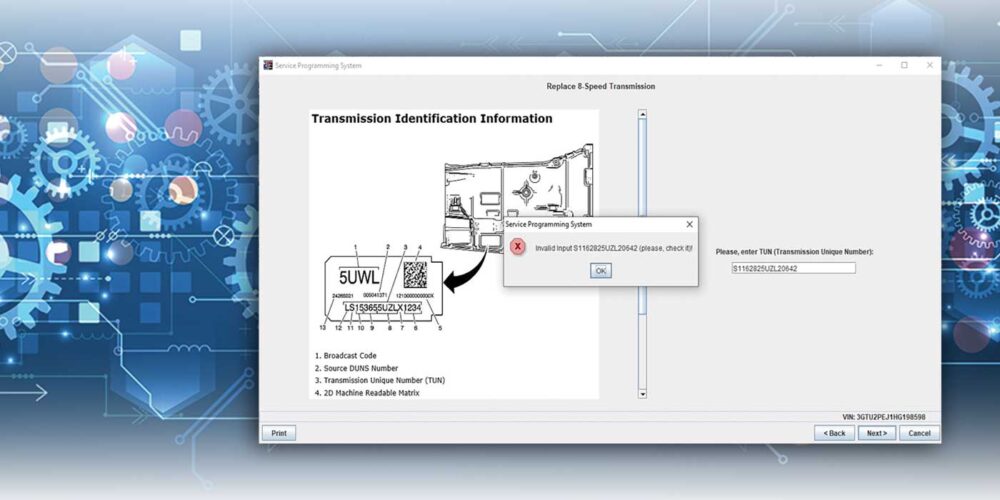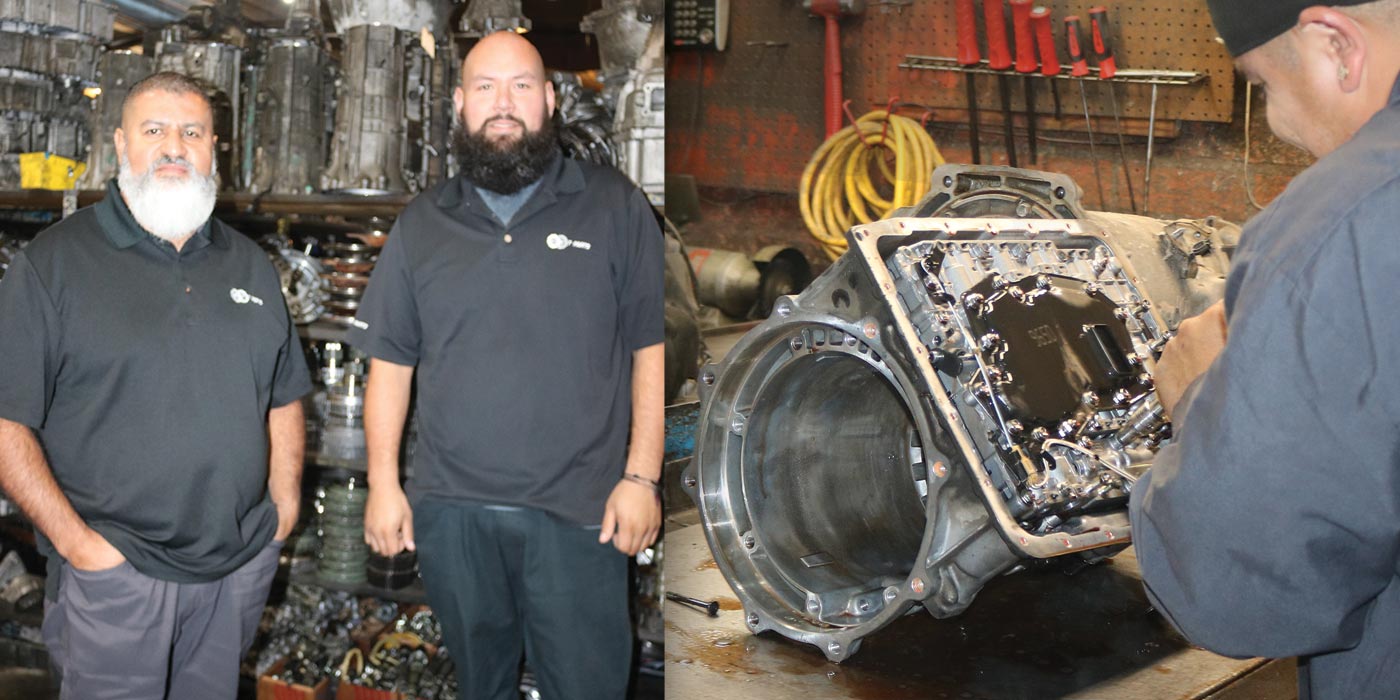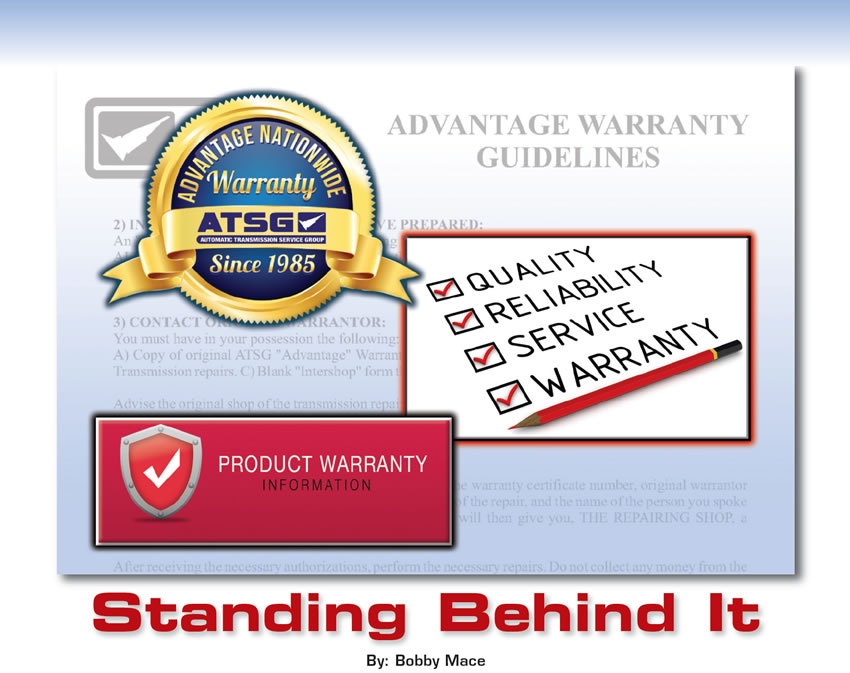
Notwithstanding the complex inner workings of the units repaired every day by retail repair shops, there’s likely nothing more complex for a shop owner to understand than profiting from the warranty offered on transmissions and other powertrain rebuilds. If you have a Ph.D. in statistical analysis, you may be slightly ahead of the rest of us, but this is one of those areas where the science melds with the arts of experience and knowledge.
It is important to understand why a shop can and should be providing a warranty to customers. Every potential customer (including yours) wants to purchase the best value for dollars spent. But, to the typical vehicle owner, what you do is turn a defective car into one that operates correctly. Terms such as bench-built, rebuilt, overhauled and reman R&R all translate in the minds of a motorist to FIXED. In other words, there isn’t any perceived mechanical difference between a transmission job at your shop and a transmission job at the shop around the corner.
Everybody has a sales pitch
The shop manager can promote the experience of the builder and the reputation of the shop until he’s blue in the face without winning the hearts and minds of a potential customer. And, in a day when transmissions typically last longer than the original ownership, there’s not a lot of repeat business to build on. In the vast majority of situations, a decision comes down to two related factors: price and warranty.
Your potential customer knows that the expense of fixing a transmission is something he doesn’t want to encounter again in the foreseeable future. In fact, the success of long-period warranties on relatively expensive reman units emphatically indicate that customers are willing and able to purchase insurance policies (warranties) for their own peace of mind. Of course the mystery is how much is enough to collect now for services you will be called upon to deliver in the future. What amount shall you add to a cost-based rebuild price in order to cover the comebacks you’re going to experience days, weeks or even years in the future?
Everybody has comebacks!
Let’s be honest: regardless of what Transmission Digest gathers each time the industry is surveyed, with the complexity of modern transmissions there is no such animal as zero comebacks. Because there are scores of component parts in a transmission you know there are going to be failures. Hopefully you’ve come to the realization that standing behind the work you do isn’t free.
If you never see a comeback, then either you haven’t maximized the profitability from the warranty you offer, you excel at catching problems before you turn the car back to the customer, the customer takes his complaint elsewhere or some combination of these.
The expenses incurred by a shop to repair a problem are the same whether the customer brings the vehicle back or the problem is caught before the vehicle is returned. Given this reality, everybody has comebacks.
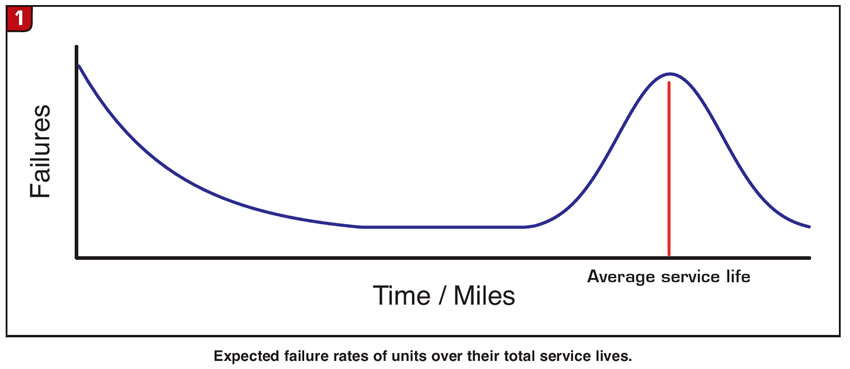
While the number of failures (comebacks) and the measurements of time are unique to each shop and each family of units, the theory of warranty pricing and length can be explained by a combined distribution diagram (Figure 1) which is made up of three sections describing the number of expected failures at each slice of time after rebuild. Each section is has its own distribution characteristics because there isn’t simply, for instance, a 4L60-E failure on a shop’s rebuilds every six weeks.
Many problems are immediately evident
The first section can best be depicted by an inverse exponential statistical distribution (Figure 2). Here are depicted immediate and near-immediate failures resulting from either faulty parts or errors made in the building process. Typically there will be a relatively high number of problems either caught by your own testing or by customers within the first days or weeks following a rebuild.
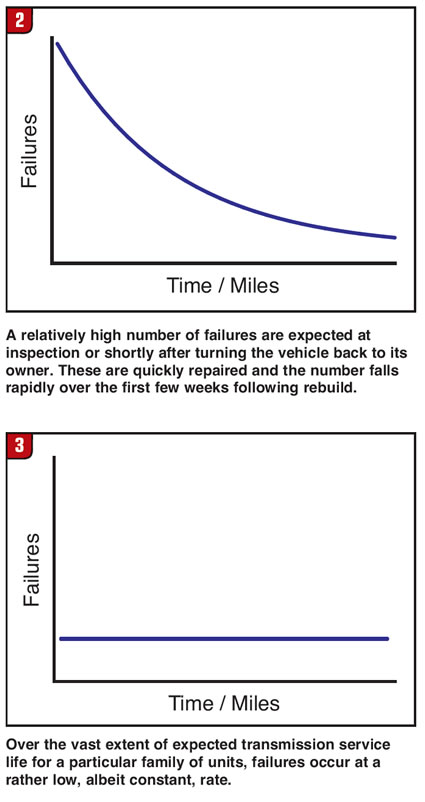
The expected life of a rebuilt unit
The second section lasts is statistically depicted by the uniform distribution (Figure 3). It lasts from those first few days/weeks until the rebuild nears its life expectancy. During this period there should be relatively few failures occurring. It is the possibility of these failures the car owner wants to avoid by having a long-term warranty. Claims that occur during this period are often caused by something the vehicle experiences such as towing heavy loads, fluid contamination, etc.
Every unit eventually fails
Finally, as a rebuilt transmission approaches its life expectancy, the failures can be described by the normal statistical distribution (Figure 4). At this point the expected number of unit failures rises to the point of the average life expectancy and then falls off in similar fashion. It is in this section that all units will eventually fail, some a few months before the average (mean) service life expectancy and some a few months after.
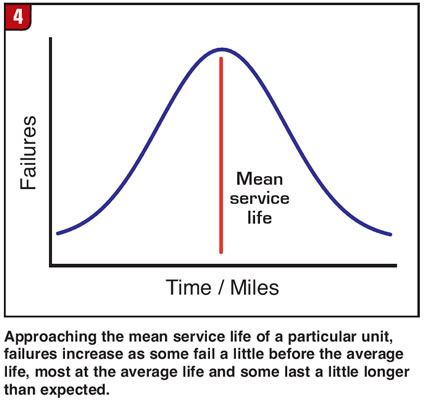
How long a warranty?
One of the factors leading to the rise in popularity of reman units being installed by retail shops has been their extended warranty, typically three years/100,000 miles (or unlimited miles) for both OEM and aftermarket reman units. Meanwhile, the traditional retail shop warranty for a unit rebuilt in-house remains one year/12,000 miles, or in fewer cases, two years/24,000 miles.
Why should a retail shop offer less of a warranty than the reman units? The clutches used are the same, the same package of paper and rubber are used in both instances, replaced hard parts are equivalent and the techniques of replacing components and re-assembling the unit are virtually the same.
For the most part, the question of warranty length is a combination of confidence in the parts installed and confidence in the skills of the rebuilder, along with an understanding and appreciation for the cost of failures that are going to take place.
It should be noted here that in many cases an independent shop should endeavor to offer the protection of a production remanufacturer’s installed unit that includes a nationwide warranty when the customer comes from out of the area, often travels cross-country or often subjects the vehicle to towing, snow plowing or any other high-torque duty.
Additionally, if you are a member of organizations such as ATSG, APRA or ATRA you may have access to a nationwide warranty program that can cover those situations. There’s a tradeoff: it is less work to purchase warranty coverage on your units without needing to do the calculations yourself. But, there is an added cost of warranty coverage because the underwriters of such warranty coverage add in a profit for themselves.
Calculating expected warranty liability
It may seem more complex but will likely be more accurate and easier to figure warranty based on the three sections shown in the diagrams. Nearly every shop has a pretty fair idea of the cost of correcting problems that occur in the first several days/weeks after rebuild. Let’s say for sake of example that a rebuilt unit is initially priced at $1,800 and that included in that price is a 10% margin. And assume that one in five rebuilds (20%) come back for problems during this initial phase. Further assume that the average cost of labor and parts to correct those problems comes to $350. During the immediate period following a rebuild, parts replaced likely are covered by a manufacturer and/or a distributor warranty. So these repairs, adjustments and modifications include only the labor and supplies used to correct the difficulty.
In our example eight of ten units don’t fail and while two fail at an expected total cost of $700. Because nobody knows which two of the jobs will experience failures, warranty insurance dictates that each and every unit bears its share of that expected $700 cost. Calculating the cost is a process of multiplying the $700 by the 20% expected rate of failure: $70/unit. Because your warranty is every bit as much of a product as your physical rebuild, add a profit margin to this figure. Let’s use the same 10% margin as an example bringing the cost of covering a unit through the first phase of the warranty to $77.
Next, calculate the warranty for the second phase of the rebuild’s life. Let’s assume that you rebuild 120 of these units a year and that after the initial failures phase you see one of them every three months (four per year) and that the cost will be the same as that of the original rebuild, $1,800. The add-on cost per unit for warranty coverage in the second, uniform distribution phase comes to four times $1,800 divided by 120 or an additional $60 per unit. Given that the original $1,800 included a normal profit, the warranty rebuild does as well.
Finally, there’s the third phase of the service-life diagrams. This is the area where all but a couple of lucky units are going to fail. Now assume that in this example that phase three begins to rise above the uniform distribution line at 53 months and that you offered a three-year (36 month) warranty. This is the optimal situation in which your warranty coverage terminates at some point before the third section (the bell-shaped normal curve) starts to increase above the four claims per year example. Because you end the warranty before that period there will be no coverage and therefore no add-on to the purchase price.
And the answer is
Simple addition finishes the price of unit with warranty to be charged to your customer:
- Actual cost of rebuilt unit with 10% margin $1,800
- Expected unit cost of short-term failures with 10% margin 77
- Expected unit cost of service life failures 60
- Total Quoted Rebuild Price with three-year warranty $1937
Accounting for warranties
Providing warranties can result in some tax advantages as well. In the example above you would recognize $1,800 of current revenue. The additional $137/unit, the expected cost of standing good on the warranty is carried on the books as a deferred liability, meaning that it isn’t counted as income until the warranty work is performed. At that point, the cost of providing the warranty work is applied against the realization of the revenue so that net profit (or loss) is reported as the difference. As I am not an accountant, the details of setting up these transactions in your books should be something you discuss and plan with a CPA or other knowledgeable expert.
Review warranty profitability
Even if your estimates of future warranty claims are dead on, chances are they will change over time. The cost of covering a THM 350 is vastly different from those to cover a 6L80E. Budget some time each quarter or at the very least each year to review your expectations as to the costs of future warranty claims and the price you should be adding to the basic rebuild in order to recover those costs.
Marketing you warranty
Once you have a handle on what your warranty costs, there are a number of options for creating a program that will be attractive to the customer. As long as you keep in mind the expected costs as relates to the service life of the unit as depicted (Figure 1), you are free to create any combination of benefits you like.

Take a lesson from the budget airlines that have a very low initial fare that increases with checked baggage, advance seating assignment, etc. For example, you might offer a two-year standard warranty and then offer options for a third and even a fourth year for a fee. While that’s a more complex pricing process, the procedure is the same figuring expectations of comebacks in the first two years as described above and then looking at any increase in probability of failure during years three and four.
In our example the four-year probability of failure would be included in the uniform distribution phase; you’ve already figured these failures into your rebuild price. Charging a little extra is insurance for your shop and a recognition that the customer finds value in the peace of mind that comes with the coverage.
Don’t forget you have warranties too
In controlling your costs don’t forget that your suppliers offer warranties to you. Consider that a comeback occurs 15 months after rebuild because of a torque converter issue. If the torque converter carried a two-year manufacturer’s warranty, then you have purchased insurance coverage for the failure. The manufacturer will send an exchange converter unit so that the shop’s liability is limited to labor to remove and replace. That same converter failure experienced at 25 months would not be covered by the manufacturer and therefore the shop’s liability on such a failure would be the replacement converter less exchange plus the labor to remove and replace.





